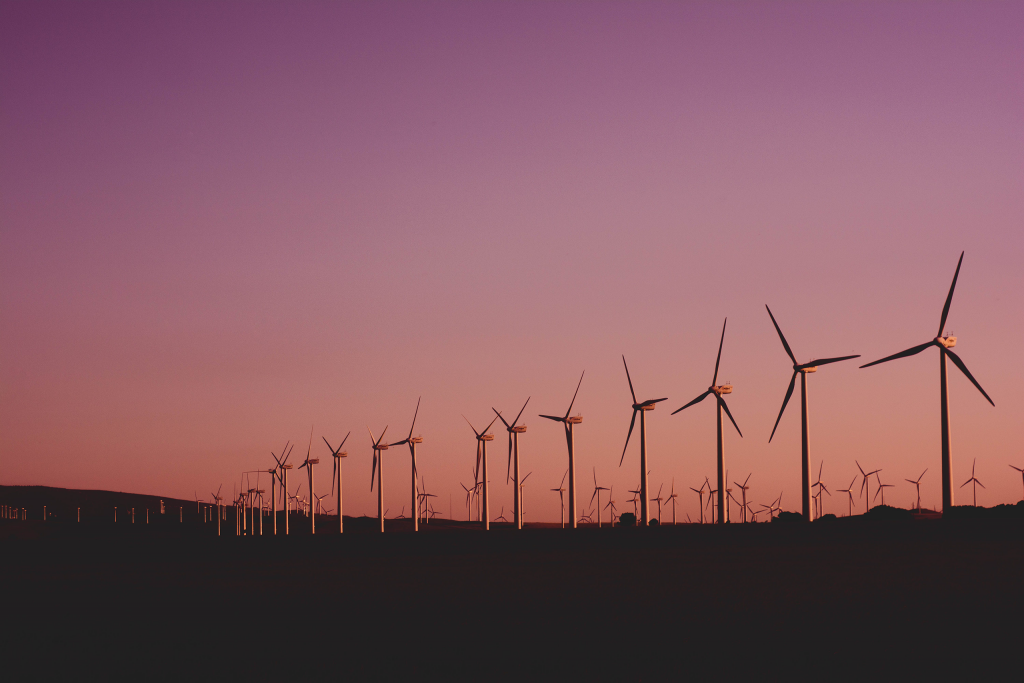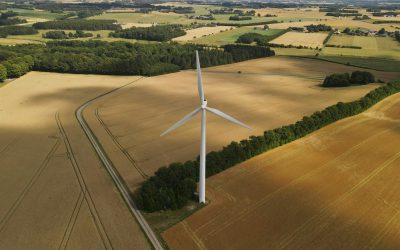Wind Power
Wind is a renewable energy source. Overall, using wind to produce energy has a lower environment impact than many other energy sources. Wind turbines do not release emissions that can pollute the air or water (with rare exceptions), and they do not require water for cooling. Wind turbines may also reduce the amount of power generated using fossil fuels, resulting in lower total air pollution and carbon dioxide emissions. [1]
Wind energy offers many advantages, which explains why it’s one of the fastest-growing energy sources in the world. To further expand wind energy’s capabilities and community benefits, researchers are working to address technical and socio-economic challenges in support of a decarbonized electricity future. [2]
An individual wind turbine has a relatively small physical footprint. Groups of wind turbines, sometimes called wind farms, are located on open land, on mountain ridges, or offshore in lakes or the ocean. [1].Wind turbines, like windmills, generate the wind’s energy with propeller-like blades. These blades can have a horizontal axis, like a fan, or a vertical one, like a merry-go-round. The most common design is a tall tower with three large blades on a horizontal axis. But some vertical-axis wind turbines look like eggbeaters, while others look like the windmills that populated farms a century ago.
Unlike fans, which use electricity to move air, wind turbines use moving air to generate electricity. When the wind blows, its force turns the blades, which runs a generator and creates clean electricity. However, some turbine designs can produce more clean energy than others. For example, because winds can be more powerful and less volatile in the atmosphere, placing turbines on towers 100 feet (or 30 meters) tall—about the height of the Statue of Liberty—can help them generate more electricity. Wind turbine operators can also shift their machines to face directly into the wind—a technique called yawing. [3]
There are several ways to get power from wind energy. Wind turbines can be built on land, on lakes or in the ocean, in the remote wilderness far from the power grid, within cities, or across vast plains. One wind turbine can power an individual home or farm, but several built close together form a wind energy plant or wind farm. Wind plants can be land-based or offshore, and they can be hybrid plants (meaning, they include other sources of energy, such as solar energy). Wind energy researchers are trying to learn how many wind turbines are built in which arrangements can maximize energy production in wind plants. {3}
Today, most grid-connected wind plants are at least 1 megawatt or larger. The biggest wind farm in the United States spans 100,000 acres (enough to cover half of New York City) and can power more than 250,000 homes. [3]
Wind Power has a lot of Challenges [2]:
- First, it must compete with other low-cost energy sources. When comparing the cost of energy associated with new power plants, wind and solar projects are now more economically competitive than gas, geothermal, coal, or nuclear facilities. However, wind projects may not be cost-competitive in some locations that are not windy enough. Next-generation technology, manufacturing improvements, and a better understanding of wind plant physics can help bring costs down even more.
- Ideal wind sites are often in remote locations. Installation challenges must be overcome to bring electricity from wind farms to urban areas, where it is needed to meet demand. Upgrading the nation’s transmission network to connect areas with abundant wind resources to population centers could significantly reduce the costs of expanding land-based wind energy. In addition, offshore wind energy transmission and grid interconnection capabilities are improving.
- Turbines produce noise and alter visual aesthetics. Wind farms have different impacts on the environment compared to conventional power plants, but similar concerns exist over both the noise produced by the turbine blades and the visual impacts on the landscape.
- Wind plants can impact local wildlife. Although wind projects rank lower than other energy developments in terms of wildlife impacts, research is still needed to minimize wind-wildlife interactions. Advancements in technologies, properly siting wind plants, and ongoing environmental research are working to reduce the impact of wind turbines on wildlife.
The European wind power action plan (COM/2023/669) is based on 6 pillars and includes 15 actions to be urgently undertaken by the key public and private actors involved [4]:
- acceleration of deployment through faster permitting and increased predictability
- improved auction design
- access to finance
- creating a fair and competitive international environment
- skills
- industry engagement and EU country’s commitments
On 19 December 2023, 24 EU countries together with many leading industry representatives, signed a European Wind Charter in which they agreed to a set of voluntary commitments to support the development of Europe’s wind sector. On the same occasion, 21 EU countries submitted their concrete pledges on wind energy deployment volumes for at least the period 2024-2026. The pledges show their commitment to accelerate and ramp up the deployment of wind in the EU, both onshore and offshore. [4]
The wind energy industry is working to figure out what research areas need more attention to expand the use of wind energy. This includes understanding how wind interacts with a turbine behind (downwind from) another one, evaluating the best ways to verify new technologies, and incorporating feedback from communities living near or using wind turbines. Researchers are studying different materials and designs that could make wind turbine blades lighter, longer, more durable, and better at creating energy. New technologies could also make wind turbines less expensive to manufacture, install, operate, and maintain, making wind energy more accessible to more people. As a bonus, some new materials and processes could make wind turbines more reusable or recyclable, which can cut down on waste, too. Scientists are also studying ways to limit wind turbines’ impact on wildlife. For example, sound and light could warn birds and bats to fly around wind turbines. And even though wind turbines must be installed far enough from homes that they produce noise no louder than a refrigerator’s hum, researchers have discovered ways to further reduce their noise levels. Because wind turbines are a significant source of clean energy, they lower pollution to help keep the Earth (and, therefore, its birds, bats, and humans) healthy. [3]



